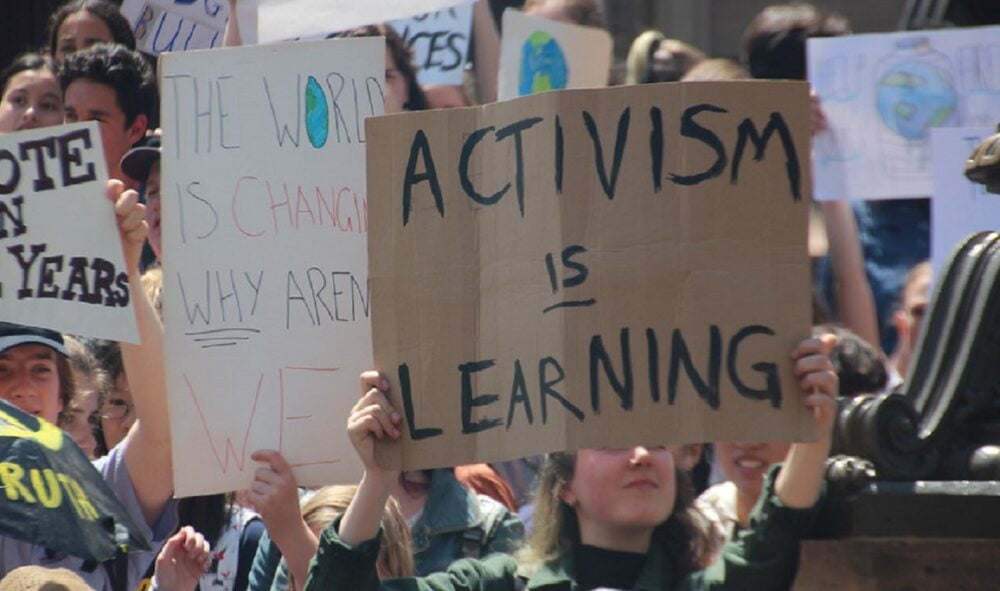It’s the first day of Introduction to Engineering and Design. I introduce myself to my students, listing my academic credentials, describing my research interests in sustainable engineering, education, and science policy. I pull up a photo of myself at the most recent March for Science in New York City, and I tell the students as an engineering educator, my goal is to train socially just engineers. As the words leave my mouth, I’m surprised at how nervous I feel saying this. I’ve introduced myself this way countless times to audiences including students before, but somehow in front of my own class I felt uncertain about sharing my work in advocacy.
I wondered to myself: had my students thought about the intersection of science and society before? How has attending school during a pandemic and climate crisis shaped their understanding of science and democracy? Did I sound like I was preaching some hidden agenda?
Starting the conversation
I’m thankful that during the semester, I would find that my students were glad to discuss science and policy in our classroom. I began small. First, ahead of New York’s voter registration deadline, I brought a stack of registration forms to class and simply said that they would be available to anyone who needed to update their registration. A few students grabbed forms, and we shared our voting plans before beginning the class session. I emphasized science-focused policies that were on the ballot – for example, the environmental bond act.
A few weeks later, in a discussion of engineering design, we discussed the racial disparities in COVID-19 due to implicit bias in the design of pulse oximeters. As the course came to a close, we came back to the idea of engineering and social justice, discussing the importance of engineering ethics and the responsibility of engineers to truthfully communicate data (unlike, as we discussed, oil and gas companies have done).
The conversations were not always easy, and we had limited time for them during the semester, but starting them felt important. Starting these conversations, hopefully, would allow students to look at their own work and ask: who did their designs potentially serve and who did they harm? Who did they include or exclude? How can we do better?
I’m excited to see where these conversations go in the future.
Out of the lab, into the streets
As I’ve started to bring science advocacy into the classroom, March for Science NYC has continued to organize our efforts citywide. For the midterms, we partnered with Science Rising, the Climate Science Legal Defense Fund, and NYC Votes to host a series of virtual training sessions on the intersection of science and democracy. We followed up with an in-person voter registration drive in a local park; to our happiness, many folks we spoke with were already registered, and instead had many conversations about the importance of advocating for science and justice. Many expressed thanks for our work, as well as shared familiar sentiments like:
“It’s hard to believe we need to even demand we stand up for science.”
“I went to the marches a few years ago, but now we have a Democrat in office!”
While the election of former president Donald Trump catalyzed our movement, disregard for science, or its use for injustice, was not unique to the previous administration. The Biden administration has fumbled public health policies and continued investment in fossil fuel infrastructure. In New York, our mayor has similarly done away with COVID protections, and perpetuated harmful narratives around public safety and mental health.
In short – the fight for science is far from over, and the lack of regard for science on both sides of the aisle has only emphasized that more for our team of scientists and engineers. As I’ve spoken with my students, this means tackling inequity from the start – the ways that we do science – and as in conversations with the public, to finish – the ways that we implement technology and use science to inform decision making at all levels.
Staying engaged beyond the election cycle
Staying engaged, of course, is no easy task. It’s easy to burn out – five years of organizing, three years into the pandemic, there have been times that it’s been difficult to focus. And rest is important. But there are always small wins to celebrate, from a student grabbing a voter registration form, to seeing new faces at a training, to the passing of a local environmental act. There is always joy to find in community, and as we enter a quiet period before the 2024 election cycle, I’m excited to continue learning with other science advocates around me.
If you’d like to get started with this work, the Science Rising resources remain a great resource for bringing conversations about democracy into scientific spaces. March for Science will continue to bring scientists and decision makers together to discuss equitable, science-based policies; our satellite in the city is active, as well as our Discord channel connecting advocates around the globe. Now is always a good time to get involved!

